The Museum Collections
Introduction
I. History and Art Collection
1. Icons of the 14th – 19th centuries
icons of the 14th – 17th century
2. Jewelry art of the 14th – 20th century
jewelry art of the 14th – 17th century
jewelry art of the 18th – 19th century
the european silver 14th - 19th centuries
3. Small-size sculptures (works of metal, wood, bone)
XI – the beginning of the XX century
Small-size sculptures 11th – 17th century
Small-size sculptures 18th – early 20th century
enamel of Troitza masters 15-8th – early 20th century
5.Embroidery, lace, textiles of the 14th - early 20th century
icon and ornamental embroidery
gold and silver lace
6.Painting of the 18th – 21st centuries
painting of the 18th – 19th centuris
painting of the 20th – 21st centuris
II.Manuscripts and old printed books of the 14th – 17th century
IV.Lithography of the 18th – 19th century
V.Numismatics
VI.Medals of the 18th - early 20th century
VIII.Archeology collection
IX. Russian folk and applied and decorative art of the 17th – 21st c.
1. Artistic wood
folk carved and painted wood
wooden toys
house carving of Sergiev Posad
Khokhloma and Gorodets painting
2. Artistic textiles
embroidery and weaving
printed textiles and lace
Russian shawls
folk costumes
folk garments
printed cotton kerchiefs
|
Russian shawls 18th – 20th century (P.1)
|
Russian woven shawls
ÑFrom the end of 18th century the manufacture of pattern silks, brocade and big scarves and the shawls similar to the Kashmir successfully developed in Russia. Russian shawls of the beginning of a 20th century on their quality, complexity of a pattern and a colouring did not concede European, and often surpassed them. The factory of the state councilor Dmitry Apollonovich Kolokoltsev was build on in the Ivanovo village of the Petrovsky district of the Saratov province in the beginning of 19th century, and existed in the middle of 1830 also. V.A.Eliseeva’s, N.A.Merlina’s and D.A.Kolokoltsov's factories were considered as the best in the country.
The pattern of shawls was bilateral. It was attained by application of technique as tapestry pattern weaving at whom a thread of colour weft intertwines with basis threads in borders of an element of pattern, without reaching cloth edge. The border of an element of pattern owing to an interlacing of threads of a background and a pattern has through apertures. The pattern on obverse and purl sides is identical. For shawls the border and the middle were separately weaved, then they were sewed. The fragment of Kolokoltsov’s shawls with a flower garland from collection of our museum is indicative in this respect.
|
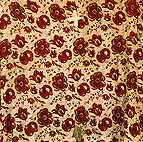
Veil for an imperial gate. 19th century. Fragment. Sewed together woven shawls |
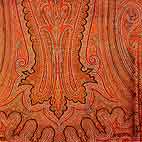
Phelonion. 19th century. Fragment. Sewed together woven shawl |
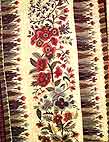
Shawl. 1820-1830th. Fragment. Weaving. Saratov province. D.A.Kolokoltsov 's manufactory |
The first shawl in Russia with interweaved in one piece with a cloth borders and corners was made at the factory of Guchkovyh brothers, whose shawls had a rich pattern, excellent furnish and, as contemporaries marked, was fine and filled of taste.
Russian shawls of the first half of 19th century have their style features. Their composite decision is fine and diverse. A narrow pattern border on edge with festoons and garlands of the small florets similar to grains of pearls, strung on a thread, underline a background’s whiteness. Alternation of colour stains - red, blue, green - creates a quiet rhythmic harmony. In the first half of 19th century there was widespread a traditional composition of east ornamental forms with, “cucumbers", "beans "and" fans ", combined with realistic treatment of flower and vegetative motives.
|
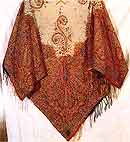
Shawl. The middle of 19th century. Russia. Weaving |
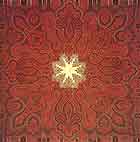
Scarf. 19th century. Weaving |
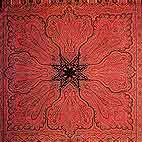
Shawl. The middle of 19th century. Russia. Weaving |
Russian printed shawls
In second half of 19th century along with manual weaving manufacture of carpet scarves on jacquard machine tools accepts mass character.
In imitation woven shawls Russian manufactories began to let out cheaper ones - printed. Woollen scarves and shawls jammed manually till the end of 19th century.
Printed textiles process is difficult and long. At first weaved matter bleached, and then it passed a number of preparatory operations before colouring. A textiles cut on size of scarves and strengthened on a wooden frame. Depending on size of a scarf the pattern broke into 4, 16 or 24 parts. Each of pattern parts was reproduced on a stuffed board - the wooden form. For this purpose from the drawing intended to execution, „removed a tracing-paper ", notably contour of the drawing it was translated on the oiled paper, and the contour of each color became separately. Drawing was beat by tacks on corners, and by light beating a hammer transferred a slate pencil contour from a tracing-paper on slightly humidified wood.
|
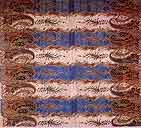
Shawl. The middle of 19th century. Russia. Printed textiles |

Shawl. The middle of 19th century. Fragment. Russia. Printed textiles |
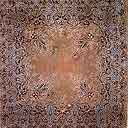
Shawl. 1830th. Moscow. Guchkov manufacture. Printed textiles |
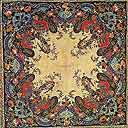
Shawl. The middle of 19th century Russia. Printed textiles |
At the beginning printed shawls reminded Oriental textiles with "roads" - pattern strips from flower branches, freakish leaves. Printed shawls with a border appeared almost simultaneously. The motive of "cucumber" still was used in different variants. From "cucumbers" various combinations were created: that intertwining, whimsically alternating, gathering in bunches, they filled almost all field of a scarf, forming a continuous carpet pattern. As the composite centre from a pattern the small free middle served in a kind êðåñò÷àòîé or a star figure. Beams "cucumbers" and "fans" dispersed from it to corners and a border. They had an accurate contour and the smallest study of details.
The big woven shawls were used sometimes in church as a veil to an imperial gate, and by printed shawls on a lining became covered lectern. The cross from a braid was sewed on such shawls at the centre.
|
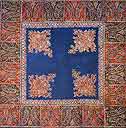
Shawl. The middle of 19thcentury. Russia. Printed textiles |
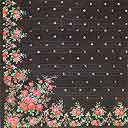
Shawl. Second half 19th century. Russia. Printed textiles |
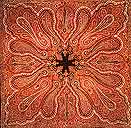
Shawl. Second half 19th century. Fragment. Russia. Printed textiles |
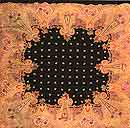
Shawl. The middle of 19th century. Kaluga lips. Aleksandrov's manufactory. Printed textiles |
|


